Why We Build Camper Vans on the Mercedes Sprinter Van Platform
Why We Build Camper Vans on the Mercedes Sprinter Van Platform
Converted camper vans are all the rage nowadays. The term camper van conversion comes from the fact that the high top vans being transformed into campers these days are actually manufactured with the intended use of a cargo van. There are multiple options when it comes to high top cargo vans that can be converted into campers.
Muse & Co. Outdoors has chosen the Mercedes Sprinter as our go-to platform for building our state-of-the-art camper vans. Curious why the Sprinter van is our platform of choice? Keep reading to learn all the unique benefits of Mercedes Sprinter camper vans.
Reliability
If you’re going to spend the money on a camper van conversion that will last for decades, it only makes sense to have a van that will last just as long. The Mercedes Sprinter van has a longstanding reputation for excellent reliability.
The Sprinter utilizes a German-built engine, which can come in either a gasoline or diesel-powered configuration. The engines get great gas mileage considering the size and weight of the vehicle, and the diesel engines in particular are known to run well over 400,000 miles.
Aside from longevity, the superior reliability of the Sprinter should be a major factor for anyone looking to take their camper van off the grid. The worst-case scenario for many van owners is suffering from mechanical problems deep in the backwoods and out of cell range. Sprinter vans are reliable not only because of their long-lasting engines, but also because the rest of the chassis and vehicle are built to easily withstand rugged environments.
The bottom line? If you’re going to invest in a camper van conversion, Sprinter vans are the only vehicle that you can rely upon for longevity and rugged performance.
Features and Drivability
The Mercedes Sprinter van is the only cargo van option that is, well, a Mercedes. Why is this important? Because this high-end van is packed with features and options that make it easy and safe to drive, and more capable than any other van on the market.
One of the deciding factors for many prospective van owners is that Sprinters offer the only factory-ready 4×4 option when it comes to cargo vans. 4×4 is simply a must-have for many van owners who want to push the edge of adventure without being held back by the capabilities of their vehicle. Whether you are a skier who frequently drives on snowy mountain passes or a mountain biker who finds themselves on long, steep dirt roads, having a 4×4 vehicle can mean the difference between making it to your destination, or not.
Aside from the 4×4 option, Sprinters come with a myriad of other features that make them much easier and safer to drive than the competition. Examples include Crosswind Assist, which senses the presence of crosswinds against the sail-like side of the cargo van, and adjusts the brakes of individual wheels to keep you safely on the road.
Additionally, Sprinters get surprisingly good gas mileage. Depending on the engine configuration and length of the van, you can get as high as 22 mpg combined in a Sprinter, which is astonishing for such a large and powerful vehicle.
Despite being a long and tall vehicle, Sprinter vans are surprisingly nimble and comfortable to drive. They have ample power for getting up to speed. They are easily maneuverable in city environments and campgrounds, and comfortable to drive for long distances on the highway.
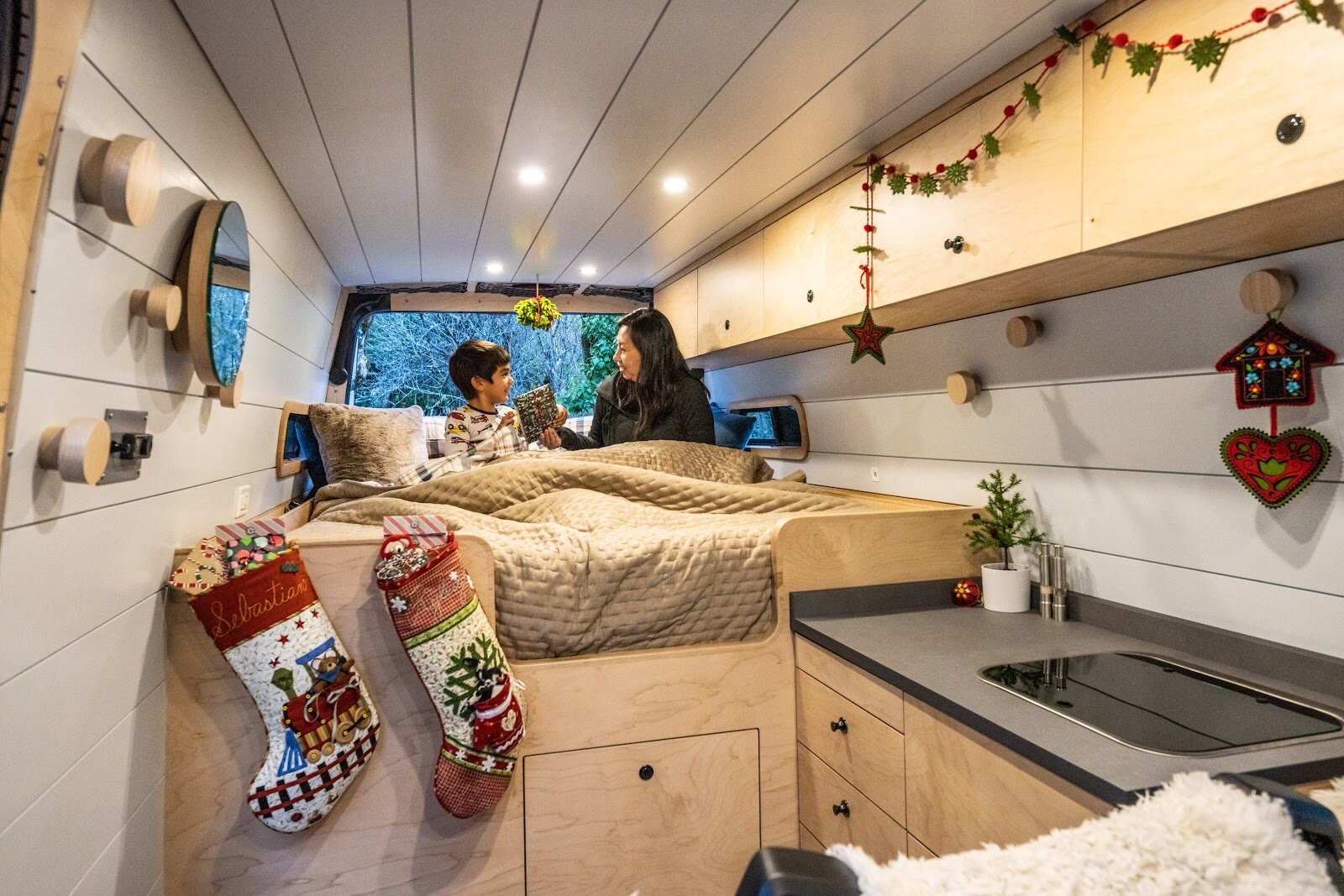
Photo credit: Muse & Co. Outdoors
Interior Space
Sprinter vans come in 3 lengths – a 144” wheelbase, a 170” wheelbase, and the 170” wheelbase extended length. Different roof heights are also available, but for the purposes of a camper van, standing is a must and the high roof is simply the only way to go.
The different wheelbases allow for varying configurations based on your needs. Our standard models utilize the 170” wheelbase, which allows for a queen-sized bed to be oriented from front to rear, while also leaving room for a kitchen and extra seating. If you go with the 144” wheelbase, most will opt to orient their beds from side-to-side to leave room for the rest of the build, which means a few less inches of bed length. For shorter folks and those who are set on the smaller wheelbase, this is still a totally viable option.
In addition to offering multiple options for length, Sprinter vans come with plenty of roof height. This means that even taller people up to 6’ 5” or so will be able to fully stand in a built-out Sprinter camper van. Some other cargo van options, such as the Ram Promaster, have a shorter roof height that makes the van feel less roomy and unable to accommodate taller people.
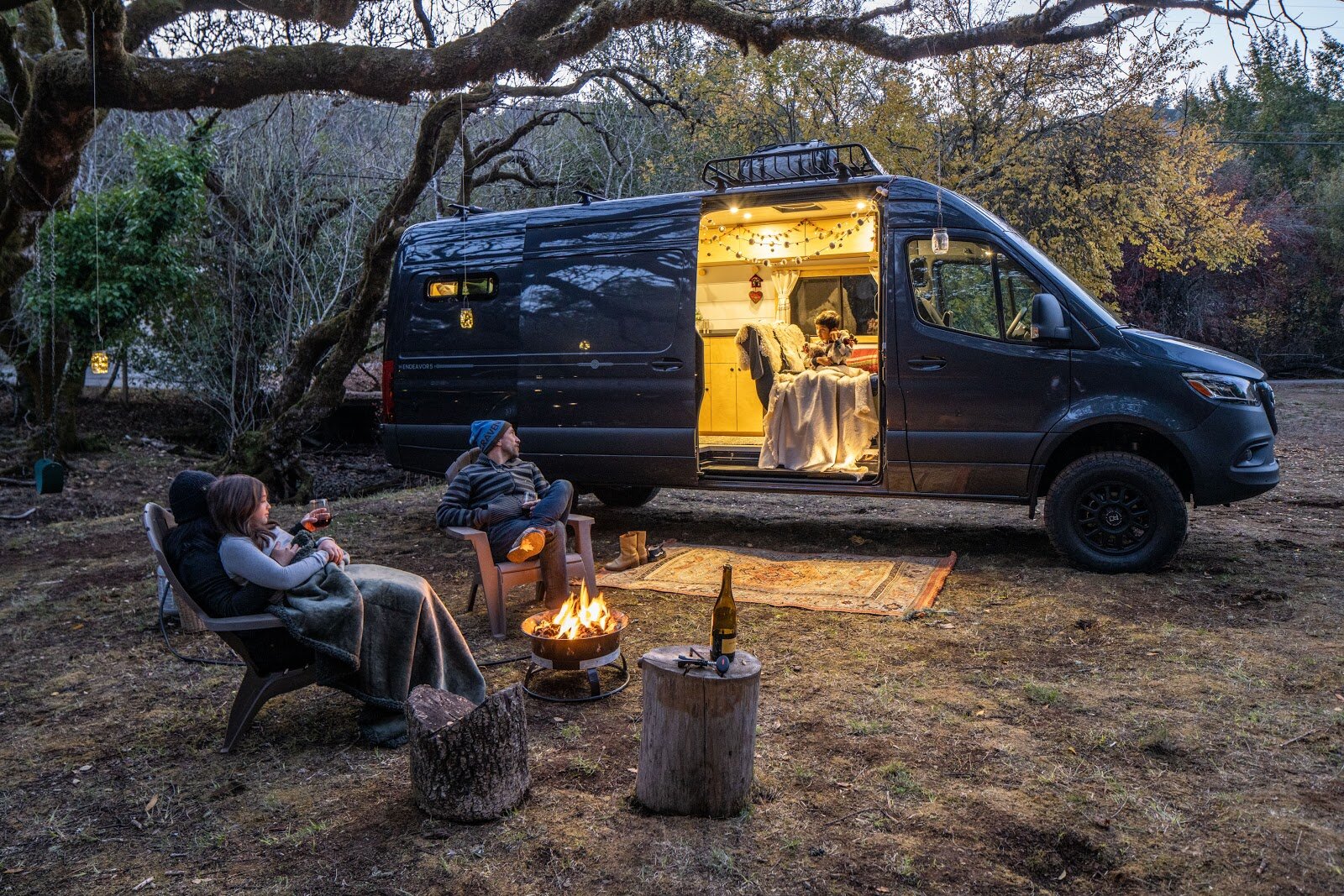
Photo credit: Muse & Co. Outdoors
The Bottom Line
The truth is, there was never another option for us when choosing a van model to offer our standard builds in. The Sprinter outperforms other cargo vans in virtually every way, and it does so in a sleek and rugged package that will offer you reliable performance for decades to come. Need 4×4 to get your van to the places you love most? Sprinters are the only van that can offer this key option.
Are you ready to make your Sprinter camper van dreams a reality? Head over to the Build My Van tool to start building your dream rig!
Why Are Sprinter Camper Vans so Popular?
Photo by Muse & Co. Outdoors
So, what is it about Sprinter vans that has led to their surge in popularity in recent years? Is the #vanlife movement here to stay? As the leading Bay Area camper van builder, we have unique insight into this movement and the vans behind it. Keep reading to learn more about Sprinter vans, and why they’ve become so popular across the country.
What is a Sprinter Camper Van?
Let’s start with the basics. There’s actually quite a bit of confusion out there about what Sprinter vans are. People tend to use ‘Sprinter van’ as a blanket term to refer to all makes and models of high-roof vans, but this isn’t accurate.
‘Sprinter’ is actually the model name of Mercedes’ line of high-roof cargo vans. Mercedes were the first to bring this style of van to the U.S., after they had already become wildly popular overseas in Europe. And, there’s a reason why people use ‘Sprinter’ as a blanket term to refer to all makes and models of high roof vans; the Mercedes Sprinter represents the industry standard, and it’s the most popular option for converting into a camper van.
While other makes and models of high roof vans, like the Ford Transit and Ram Promaster, are also used for camper van conversions, the Sprinter offers unparalleled reliability, gas mileage, features, and build quality. These are the major reasons why Sprinter vans are the best van for a camper van conversion.
Why Are Sprinter Camper Vans so Popular?
It’s been 20 years since Mercedes brought the Sprinter to the U.S. But only in the last ten, and especially in the most recent five years, have Sprinter camper van conversions become so commonplace. What is it about Sprinter conversions that are so appealing to so many people? Will this movement last? Let’s discuss!
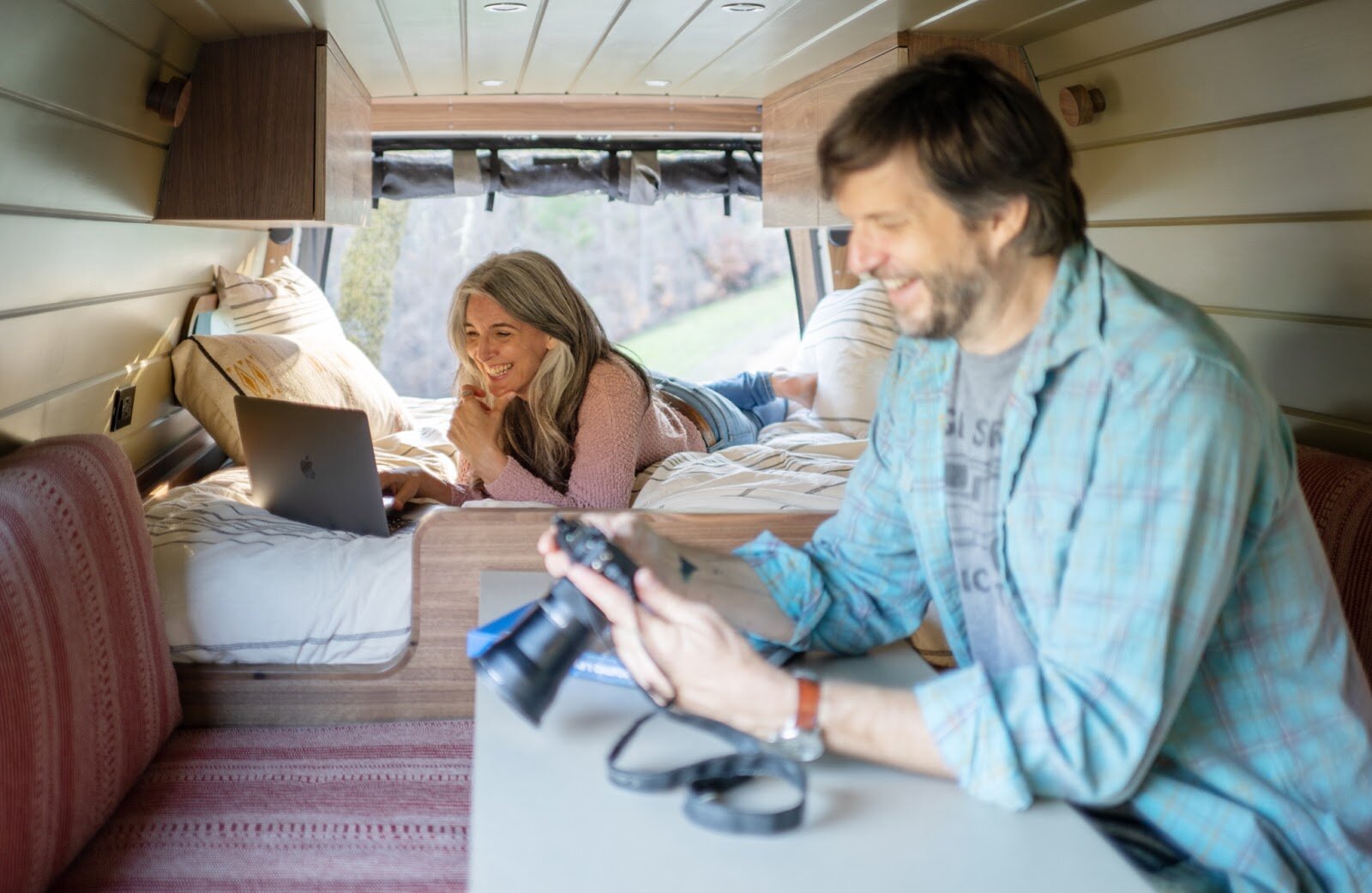
Photo by Muse & Co. Outdoors
Versatility
Versatility is the number one reason why Sprinter vans are so popular. Smaller than an RV, but with massive advantages over car camping or smaller vans, Sprinter campers are the perfect balance between luxury and convenience.
Sprinters are easily maneuverable in city environments. Depending on the wheelbase of the van, they can fit in a standard parking space. They’re tall enough to stand up inside of, but small enough to take most places a car can go. You can fit a bed, kitchen, seating area, and lots of storage in a Sprinter van, but you won’t be limited to where you can take it, as is the case in an RV. Sprinters also come with optional 4 wheel-drive, so you can use them for ski trips and to access tucked-away camping spots off the beaten path.
Despite having plenty of room for many of the comforts of home, Sprinter vans get astonishingly good gas mileage, thanks to Mercedes’ much-acclaimed line of highly efficient diesel engines. Some people even use their Sprinter camper vans as their daily drivers, as well as their adventure rigs.
Customizability
Since its beginnings, the #vanlife movement has always been about customizability. Sprinter vans are built primarily for use as a cargo or work van, so their interiors come as a blank canvas. It makes sense that customization would be such a core value to the camper van conversion world.
While some camper van conversion companies do exist now that offer RV-like, cookie-cutter camper builds in Sprinters, this is not the typical way of vanlifers. Making your Sprinter camper van your own is a huge part of what makes this movement special. Even if you buy a built-out van from a professional conversion company, you’ll want to have a say in the features it includes and the look and feel it has.
Muse & Co. Outdoors vans can be customized in several ways, from the countertop color to the option to add a roof rack. We keep our costs and lead times reasonable by offering two base models, but allow our customers to make their vans their own by choosing color palettes, materials, and accessories.
How Much Does a Sprinter Camper Van Conversion Cost?
If you’re looking into purchasing a converted Sprinter camper van, then you will surely have questions about how much you are likely to spend. Like most things, when it comes to camper van conversions, it can be said that you get what you pay for.
The truth is, the cost of Sprinter camper van conversions varies greatly depending on the materials used, the options and accessories included, and the level of craftsmanship that goes into the build. Top-tier van conversion companies will spare no expense, but the higher build costs are worth it for those who are looking for a camper van that is luxurious, capable, and will last for several years to come.
Cost of the Van vs. Cost of the Conversion
If you are going to hire a professional van outfitter to build the camper van of your dreams, you are looking at two main expenses: The cost of the van itself, and the cost of converting the interior into a camper van.
Mercedes Sprinter vans, as well as similar models that people use to build campers, are actually meant to be cargo vans. The interior comes as an empty canvas, and your van builder ‘converts’ this plain work vehicle into a beautiful camper van. Thus, your two main expenses will be the van itself, and the cost of the buildout.
When it comes to buying a cargo van to be converted into a camper, prices can range drastically. Some factors that will influence the cost of your van include:
Buying New vs. Buying Used
Buying a brand new van will, of course, be more expensive than purchasing a used van. However, factory warranties and improved performance of the newer models make them well worth the cost.
Model of the Van
There are three main cargo van models available for sale in the U.S. that are commonly converted into camper vans. They are the Ram Promaster, the Ford Transit, and the Mercedes Sprinter. Sprinters are the most expensive of the three, but also the most reliable and featured.
4×4 or 2WD
Sprinters are the only cargo van offered in a 4×4 configuration. For many adventurers, 4×4 is a must have. Of course, a 4×4 Sprinter will cost more than its 2WD counterpart.
Once you’ve settled on a van, it’s time to consider conversion costs. A professional van conversion can cost anywhere from $30,000 to upwards of $200,000. Of course, the final product you get on either end of this spectrum will be vastly different. Let’s break down the different elements that affect the final cost of a van conversion.
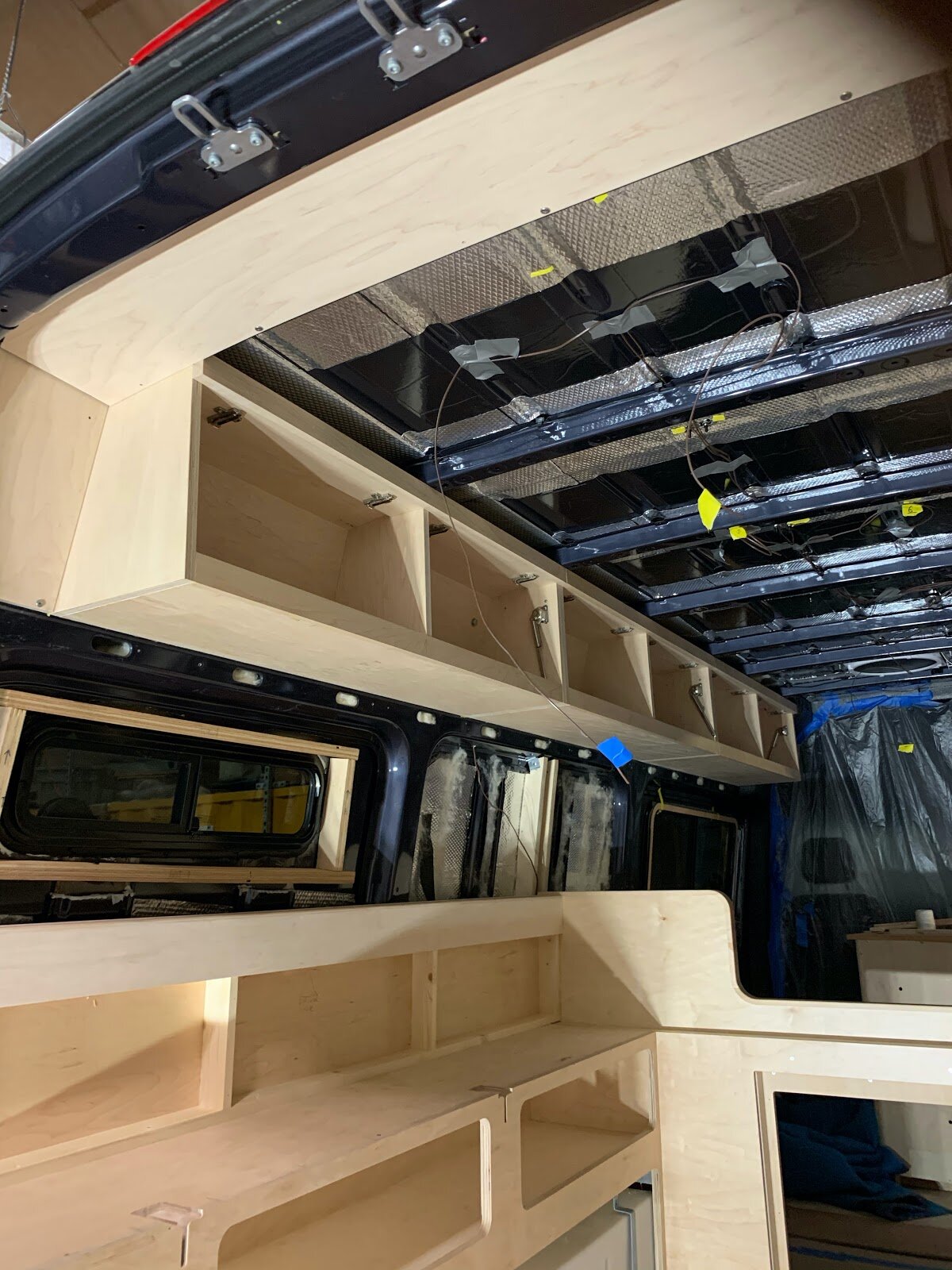
Photo credit: Muse & Co. Outdoors
What Affects the Cost of a Camper Van Conversion?
There are many factors that will affect the final cost of your van build-out. From build materials, to craftsmanship, to appliances, virtually every element of your build can vary greatly in cost depending on what is used and how it’s built. In an average Sprinter van conversion, the following aspects will determine how much the build costs:
Build Materials
In every part of your build, the conversion company will choose what build materials will be used. Cabinetry can be constructed using anything from the cheapest composite board to premium hardwood. Insulation can be done quick and cheap with messy, toxic sprayfoam insulation. Or, a builder can use a premium insulation such as Havelock Wool, which is designed for use in vans and is completely non-toxic. It’s important to know what materials were used to build your camper van interior, because some builders attempt to cut costs by using cheap materials, without reflecting this in the final price of the build.
Labor
No matter who you choose to do your van build, labor will likely comprise at least 50% of the total cost. Camper van interiors are subject to harsh conditions – from the movement of the road to large temperature swings. Hiring an expert builder is a good way to ensure that your camper van interior will last for many years to come.
Appliances and Features
There is an endless assortment of gear and gadgets that can be included in a camper van build. From 12v battery systems, to roof racks, to appliances like stovetops and fridges, you will have options for just about every component in your van. Of course, a Sprinter van has limited space, so you’ll need to choose what components are important for your build, and what you can live without. Finding a good balance between functionality and simplicity will help you to keep costs reasonable. Many builders will choose many of the components for you, so do your research and ensure that your builder is using quality gadgets. Remember, you’ll be living with your decisions – trust us, there’s a big difference between a cheap portable toilet, for exampe, and the highest quality composting toilet.
How Much Is a Camper Van Conversion from Muse & Co. Outdoors?
Muse & Co. Outdoors offers luxury Sprinter camper van conversions at an affordable price point. Our builds start around $135,000. While our base models come with many premium features included, we also have an array of add-ons and extras that can be incorporated into your build at an extra cost.
Our builds include everything you need for your next adventure, and nothing you don’t. We believe that a camper van should facilitate adventures, and provide a welcoming shelter after long days spent outside. Our decades of combined design and build experience ensure that every aspect of your build will be crafted with precision and attention to detail.
We stand by our builds with a 36,000 mile/3-year warranty. Our interiors are built to last as long as the van itself.
If you’re intrigued by the #vanlife but still thinking about how to make it a financial reality, check out this article to learn more about how to afford a Sprinter Van Conversion.
Ultimate Camper Van Guide to Yosemite National Park
Photo by Aniket Deole on Unsplash
A camper van is a fantastic way to visit the park and soak up all that it has to offer. However, Yosemite’s popularity and restrictions make it a place that is much more fun to travel to when you are in the know. Below, you can find helpful information on taking a van life trip to Yosemite, including tips on reservations, camping, and what to do while you’re in the park. Enjoy!
Camper Van Camping in Yosemite National Park
There are 13 campgrounds within Yosemite National Park. Of them, four are located in the Yosemite Valley, which is certainly the most scenic area of the park. Reservations are required at seven of Yosemite’s campgrounds, including all of the van-accessible campgrounds in the valley.
Peak season in Yosemite National Park is April-October. Campground reservations are available in one-month blocks which open 5 months in advance, on the 15th of every month, at 7 a.m. Pacific time on recreation.gov. For more campground reservation information, click here.
When planning a camper van trip to Yosemite, the first thing you’ll need to do is attempt to make campground reservations. Be aware that for May through September, and for some other weekends of the year, campsites are reserved within seconds of the 7 a.m. opening window! The 3 campgrounds that allow car camping in Yosemite Valley are Upper Pines Campground, Lower Pines, and North Pines. All three have a nightly fee of $26.
What to Do If You Can’t Get a Reservation
If you plan on visiting Yosemite during peak season, it’s a good idea to have a backup plan in place should you be unable to reserve a camp spot inside the park boundaries. . While spontaneous camping is one of the major benefits of owning a Sprinter camper van, be aware that car camping is only allowed in designated campgrounds within the park. Camp 4, Yosemite’s only first-come, first-served campground, does not allow car camping in the parking lot. This rule is strictly enforced.
Fortunately, there are several options for camping outside of the park boundaries in areas that are both beautiful and close enough to Yosemite for daily trips into the park. While there’s nothing quite like waking up in Yosemite Valley, camping outside of the park and making day trips is a great option when reservations are unavailable.
Yosemite is surrounded by national forest, and RV parks and campgrounds can be found near every entrance to the park. Hipcamp offers lots of interesting options for people on road trips who want to camp in their vans near Yosemite. Alternatively, free camping is legal in many areas on national forest land.
There are too many campgrounds near the park entrances to list here, but a quick search will help you find plenty of great options. It’s still a good idea to reserve your camping spot well in advance, even if you’re going to be staying outside of the park on forest service land.
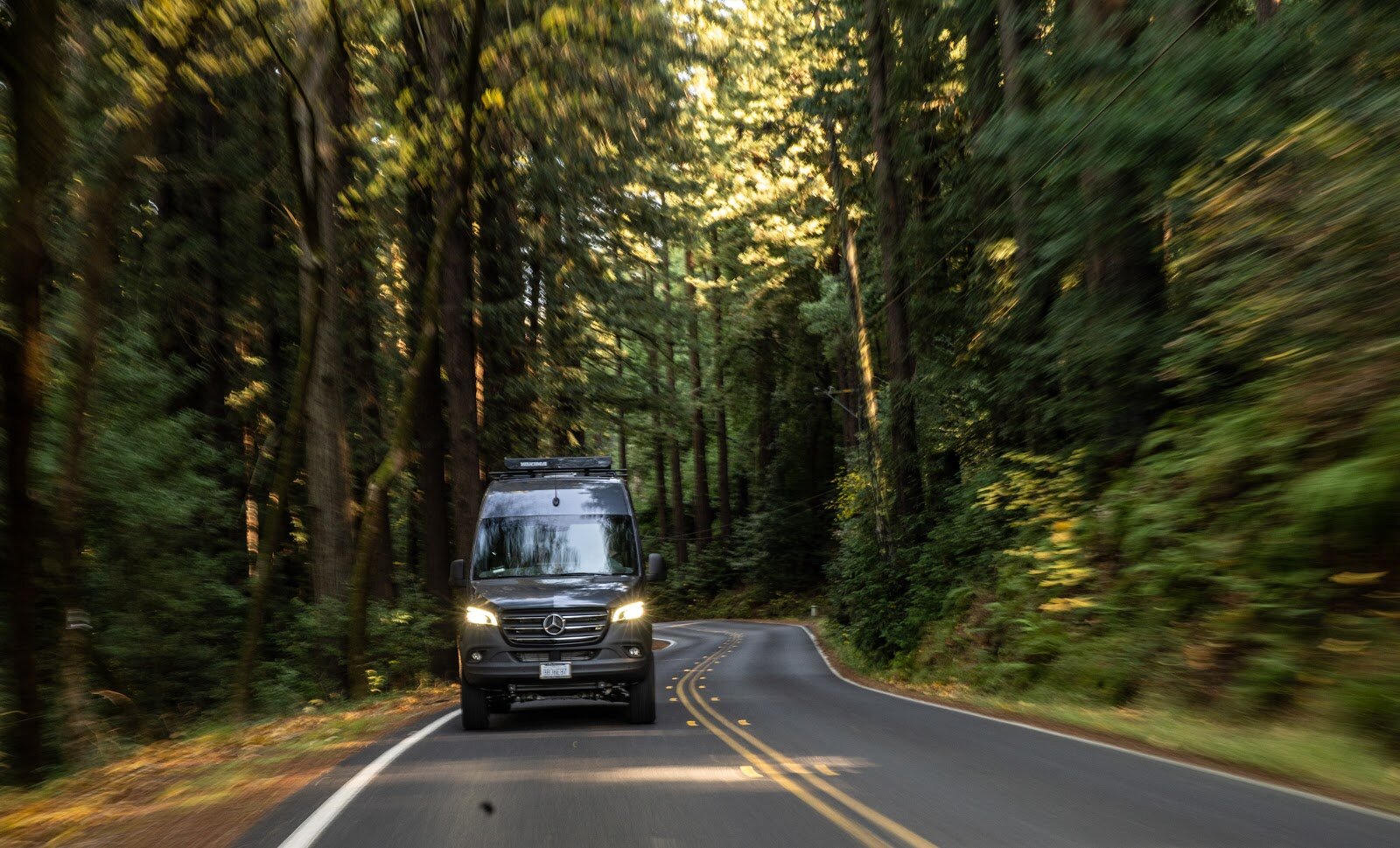
Photo credit: Muse & Co. Outdoors
Amenities for Vanlife in Yosemite
One great thing about camper vans is that they allow you to be self-sufficient while traveling. Many camper vans include showers, toilets, and kitchens. Still, it’s always good to know where you can find basic amenities like groceries, showers, and more while you’re on the road.
Yosemite has more amenities within park boundaries than most national parks. There are several restaurants and shops located in Yosemite Village. You can find hot showers most of the year at nearby Half Dome Village. (Keep in mind that there are no showers at any of the campgrounds in Yosemite).
One great resource in Yosemite is the Village Store. The Village Store is located in the heart of Yosemite Valley. It includes a small grocery store and gear shop. You can find most things you would in a standard supermarket here, including fresh produce. The Village Store also carries basic camping essentials like firewood and tarps.
If you need full RV hookups for your van, you’ll need to camp at one of the campgrounds outside of the park. Electrical, water, and sewer hookups are not available anywhere within the national park.
What to Do in Yosemite
Yosemite is one of the most popular national parks in the country. But what do people who go here actually do? Depending on the season you visit, Yosemite has something to offer for just about anyone.
You can find amazing hiking in Yosemite just about year-round. Many hikes in the valley feature stunning waterfalls and breathtaking views. There is hiking for all abilities to be found in Yosemite. During peak season, you may need to get a permit in advance for a select few trails, including Half Dome.
Yosemite is the world’s premier rock climbing destination. If you are a climber, you could spend several lifetimes in ‘The Valley’ (as climbers have been calling it for decades) without experiencing all of the climbing it has to offer. There are opportunities for novices to get high on the granite walls surrounding Yosemite Valley as well. You can take guided adventures that are suitable even for those who have never tried climbing before. For those who would prefer to watch, grab a pair of binoculars and head to El Capitan Meadow, where you can get great views of parties attempting to climb the sheer 3,000-foot monolith.
Yosemite Valley features extensive bike paths, making it a great place to cycle while you take in the astounding views. Since the valley is fairly small, you can easily get to most areas by bike if you are camping within Yosemite valley.
Another great thing to do in Yosemite is to simply drive around and see the sights. A trip up Glacier Point Road for sunset or an excursion on Highway 120 through the high sierra landscape of Tuolumne meadows offers great sightseeing and a relaxing way to spend the afternoon. Keep your eyes peeled for bears and other wildlife, especially when driving through the valley and near the Tuolumne Meadows Campground.
If you visit Yosemite during the summer, chances are it’s going to be hot! Daytime temperatures in the valley can soar over 100 degrees during summer. At the higher elevations near Tuolumne Meadows and Tioga Pass, temperatures tend to be a bit cooler, but still quite warm in the summer.
Fortunately, Yosemite has some incredible swimming holes where you can cool off. Great swimming can be found in the Upper and Lower Merced River and along Bridalveil Creek, as well as in the numerous lakes within park boundaries, such as Tuolomne’s Tenaya Lake.
With proper planning, Yosemite is an amazing place to travel in a camper van. The breathtaking scenery and ample opportunities for outdoor fun make it one of America’s top destinations. The only thing that can make a trip to Yosemite better is enjoying it from the comfort of your custom Sprinter van conversion.
~Enjoy your trip! Your friends at Muse & Co. Outdoors.
Campervan Storage Ideas for Easy Organization on the Road
Sprinter camper vans have many benefits, but their main draw is the ability to pack so much comfort and functionality into such a small living space. In a vehicle that can fit in a standard parking spot, you can have a bed, a kitchen, a garage, and space for seating and storage. It’s no wonder that the #vanlife craze is continuing to grow in the U.S. and beyond, and many people are even taking road trips and living full-time in their camper van conversions.
Of course, there are certain challenges when designing a camper van layout. Fitting so much into a small space requires excellent planning. In order to prevent a camper van from feeling cluttered, it is essential to have enough space for storage of all your items, and to maximize the storage that you do have by using it efficiently.
Many small items, like paper towel holders, heavy-duty velcro, bungee cords, and spice racks can be found on Amazon or your local department store and can go a long way to de-cluttering your van. But for the real challenge of fitting all of your major gear in your van without making it feel like a giant storage container, you’ll need some serious forethought and a perfect layout.
Keep reading to learn about some awesome ways that you can maximize the amount of storage space in your Sprinter camper van!
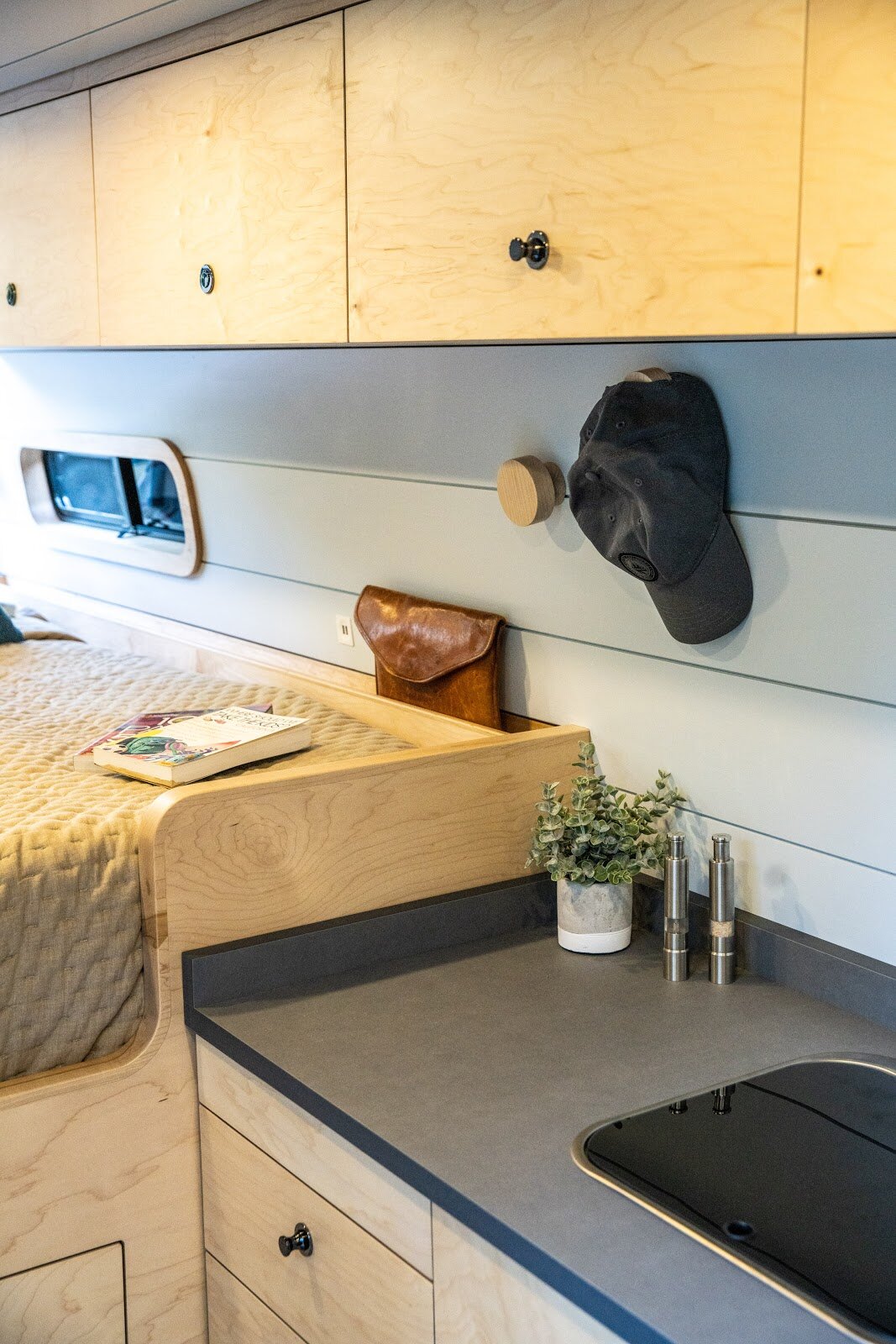
Photo credit: Muse & Co. Outdoors
Efficient Cabinetry
IIt could be argued that the most important element of any van build is cabinetry. Cabinets play many roles in most builds, including not only holding gear, but also providing structural support and a place to install appliances like a fridge or a sink. If you’re looking to maximize storage space in a camper van, the most important thing is to have cabinets that are built thoughtfully.
There are a handful of common types of cabinets in camper vans, including large kitchen cabinets, overhead cabinets, and pull-out drawers, to name a few. When it comes to building cabinetry for a van, a high level of planning and expertise is needed to truly maximize space. Far too often, the cabinetry in a van is too bulky and fails to create as much storage space as it could.
Since van walls are curved, cabinetry can be much more challenging to build and install than in a square space. The best van builders are able to work around the irregular shape of the van’s interior to utilize every available square inch of space. All van cabinets are not created equal, and you should seek out a builder that boasts excellent cabinetry skills!
Drawers, Drawers, and More Drawers for Van Life
Drawers are an essential part of the storage scheme in any van build. Drawers maximize storage space in a van by allowing easy access to all the items they hold. As opposed to cabinets or cubbies, drawers make it easy to reach items towards the back.
Drawers must be well-secured in a van to ensure they don’t come open while driving. There are a few different strategies for achieving this. Here at Muse & Co. Outdoors, our drawers are secured using magnets that are easily released when you apply force to open the drawer, but strong enough to safely keep them secured while driving. Unlike many latch options, our magnet system also has the advantage of being completely fool-proof—as long as you push the drawer closed before driving, it will stay secured.
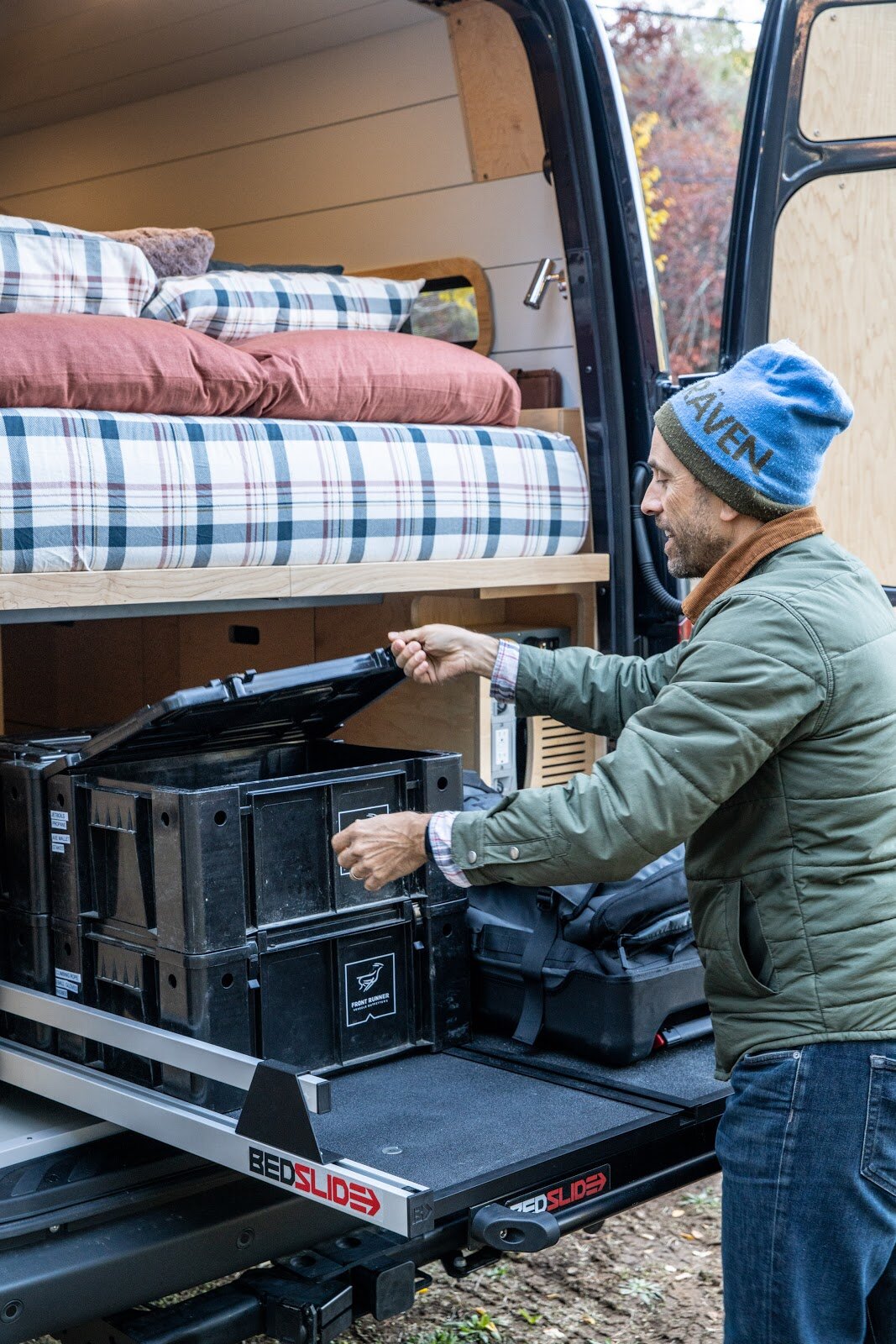
Photo credit: Muse & Co. Outdoors
Bedslide Hack
A Bedslide is a sliding platform, intended to make gear in the bed of pickup trucks easily accessible. Bedslides are extremely rugged and durable, and they boast a massive weight capacity. Similar to drawers, a Bedslide gives you the ability to access the gear farthest away from the doors.
Whether you need the extra space for skis, cleaning supplies, backpacking equipment, or mountain bikes, a Bedslide can help you maximize the interior space in your van.
At Muse & Co. Outdoors, all of our vans come equipped standard with a Bedslide in the rear. When you open the rear doors, you will have access to the “garage” area of the van, which is the area under the queen-sized bed. The garage is the perfect place to store all your adventure gear.
With the Bedslide, you can load your gear in any configuration you’d like, without worrying about how accessible any of it will be. Even the items you place farthest from the rear doors will be easily within arm’s reach when the slide is fully extended. With a weight capacity of 1000 pounds, you would be hard-pressed to find items heavy enough to even come close to the Bedslide’s maximum.
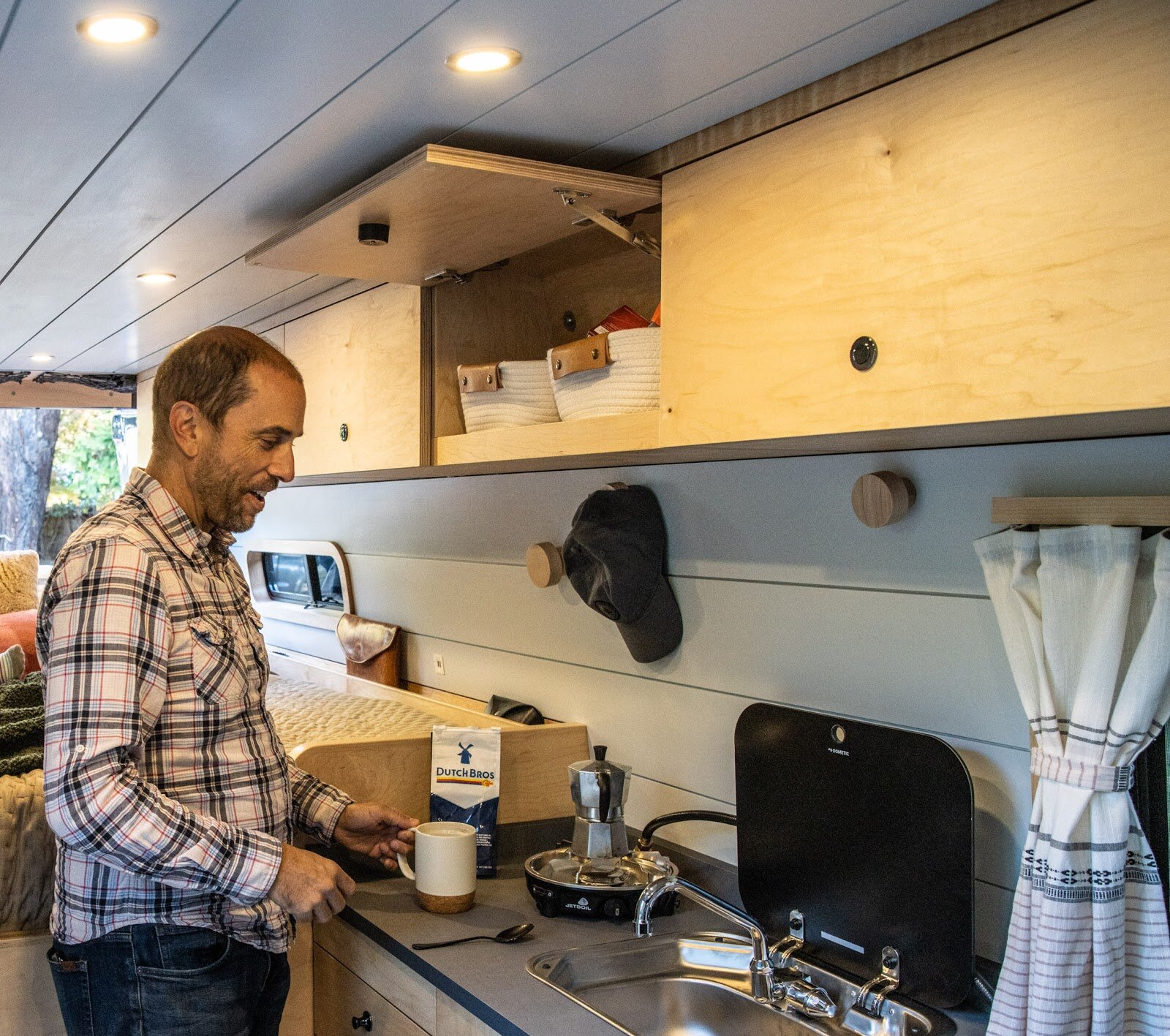
Photo credit: Muse & Co. Outdoors
Use Soft-Sided Baskets for an Easy Cabinet Storage Solution
A great way to get the most out of your van’s cabinet space is by using bins. We love to use soft-sided storage boxes in our vans – especially for items like food and toiletries – because they keep hard items from rattling against the inside of your cabinets while you drive.
The other major benefit of adding strategically-placed storage bins in your cabinets is that they keep certain items more consolidated, freeing up counter space and de-cluttering your van. Socks and underwear, and even odds and ends like laptops or cutting boards take up far less room when kept in a bin.
Shoe racks take up valuable floor space, but you can store many pairs of shoes in one bin and stick them in a cabinet, out of the way. Toiletries and pantry items can also be placed in bins, saving surface area and allowing for more of the cabinet’s vertical space to be used.

Photo credit: Muse & Co. Outdoors
Add a Roof Rack for Extra Storage Hacks
For certain travelers and outdoor enthusiasts, a roof rack is a must-have addition to free up precious space inside of the van. Kayaks and surfboards are two examples of items that can rarely fit inside of a Sprinter van. With a roof rack, you can store these large items, and you may even still have room for a rooftop cargo box which can hold even more gear.
It’s worth noting that roof racks have several other benefits aside from gear storage. They can provide attachment points for items such as Road Showers and retractable awnings, both of which are available as add-ons from Muse & Co. Outdoors.
8 Camper Van Hacks for Easy on the Road Living
The best part about #vanlife is having a tiny home on wheels that you get to bring with you on all of your adventures. Whether you’re on an extended road trip or just enjoying a weekend getaway, the comfort that a camper van provides while traveling is hard to beat.
That said, a Sprinter camper van is a small space, which means that it can take some creativity to maximize comfort and functionality on the road. Of course, the best way to ensure that you’re getting the most from your camper van is to start with a well-designed layout. But you can still improve your experience, even in the best professionally-built camper vans, by implementing some nifty storage ideas and van life hacks.
Keep reading to learn our top 8 camper van hacks to help you live more comfortably on the road!
Affiliate Disclaimer: Some of the links below are affiliate links, meaning, at no additional cost to you, we may earn a commission if you click through and make a purchase. As an Amazon Associate we earn from qualifying purchases.
Mosquito Netting: A Lifesaver
Most experienced vanlifers can tell you a story or two about leaving a window down by accident, only to realize their mistake when they find their van to be infested with mosquitos! If you plan on doing summer van camping, mosquito netting can be a real lifesaver.
Your Sprinter van conversion company might offer an option or package to add mosquito netting to your build. It’s great to have netting that is removable, and attaches to your slider door and/or window frames with velcro or magnets. On warm summer nights when the mosquitos are out, this camping hack will allow you to feel a cool, bug-free breeze from inside your van.
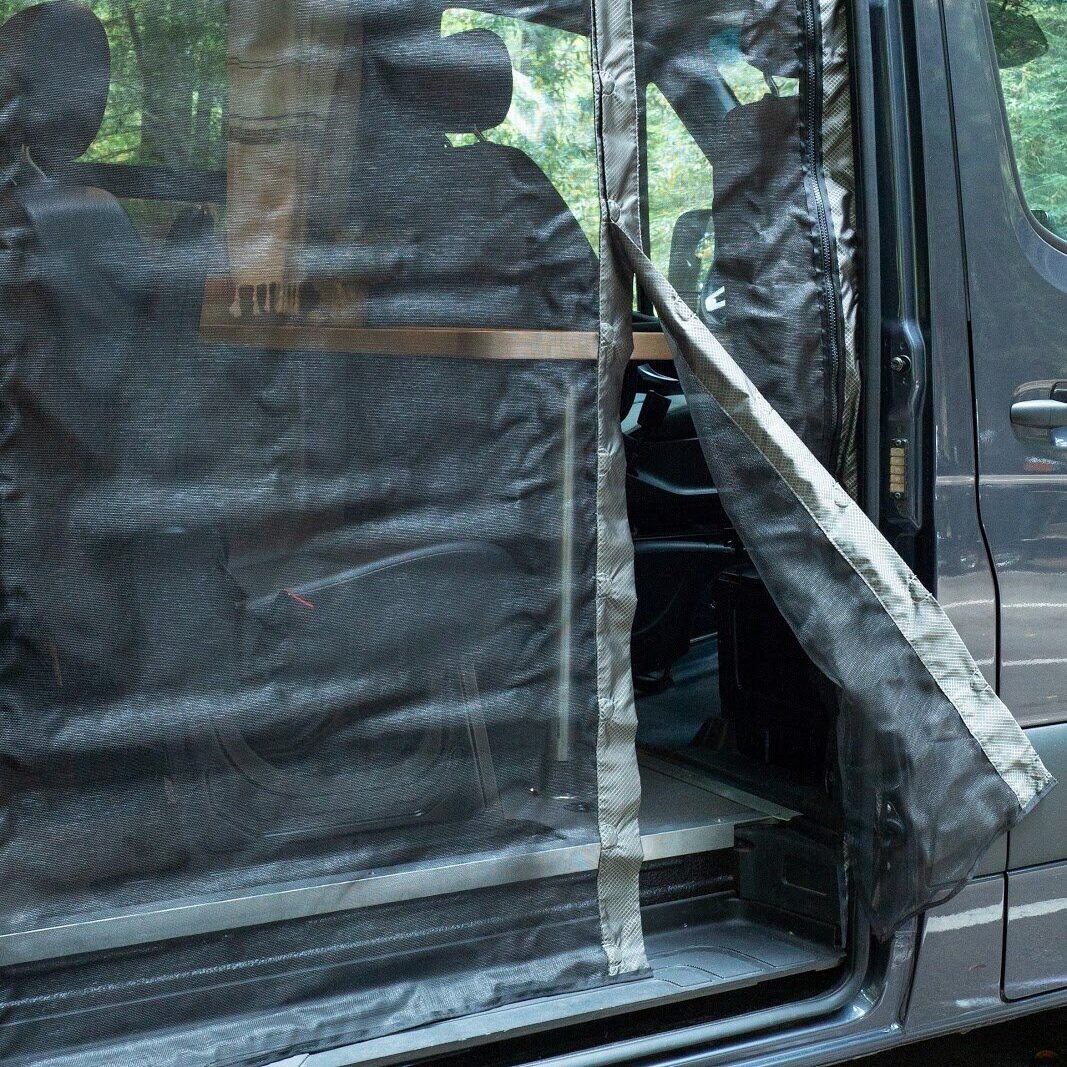
A Hammock…For Your Produce
Storing your fruits and veggies while on the road can be difficult. Drawers and cabinets are an option, but it’s hard to keep your produce from bouncing around while driving – especially if you travel on dirt roads.
A great solution is this all-time favorite campervan storage hack: Using a hanging fruit and veggie hammock to store produce. These hanging contraptions serve many purposes—they are space-saving, they look nice, and most importantly, they protect your produce from bumps and bruises.
When your van hits rough spots in the road, this van life tip will help your veggies will stay in place as the hammock rocks gently back and forth— instead of bouncing and rolling around in your cabinet.
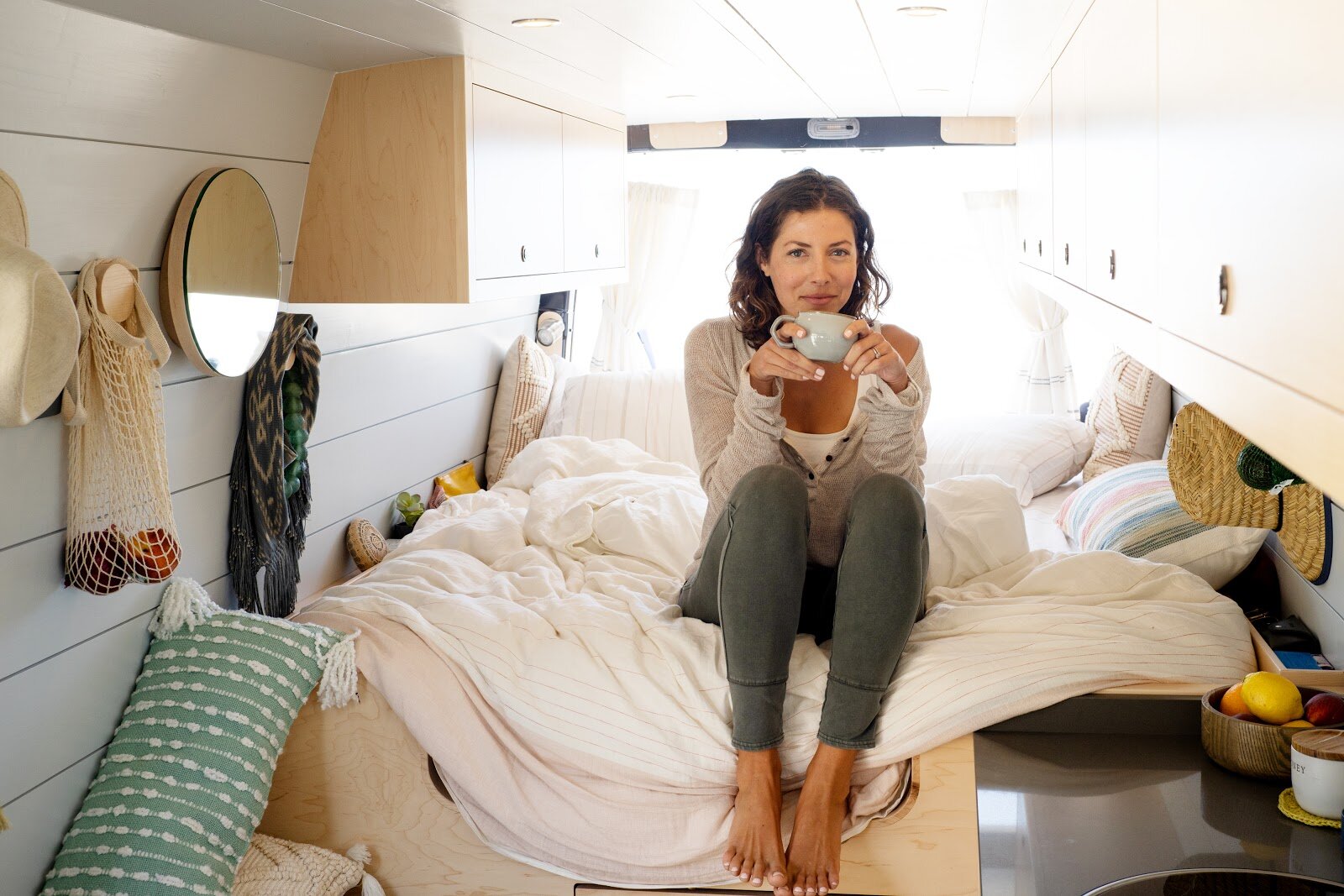
Make a Spice Rack
Organization is critical in camper vans in order to decrease clutter and save storage space. A spice rack is one of the best campervan hacks because it gives you easy access to all your favorite spices, looks nice, and keeps little glass spice jars from making noise and taking up space in your cabinets.
A popular option for a DIY spice rack among van enthusiasts is to securely attach the lids of glass jars to a surface in your kitchen. You can then fill your jars with spices and screw them into the secured lids. Popular mounting locations include the backsplash and under the overhead kitchen cabinets.

Try Collapsible Food Storage Containers
We may be able to afford the space in our home to have a chaotic drawer full of tupperware containers and scattered lids, but when it comes to van living, this waste of space just won’t fly. A great solution to food storage while on the road is to use collapsible plastic storage containers. These containers will become your best friend on the road. They can hold all your leftovers while in use, and they pack down flat for easy, out-of-the-way storage.
Get a Handheld Vacuum
Your van is bound to get dirty while you’re out adventuring. Tracking dirt and gravel in from outside is unavoidable. If you have pets, hair cleanup will surely become part of your daily vanlife routine.
Fortunately, vans are a relatively small space, and they’re easy to clean. Handheld vacuums can make life easier for van lifers when it comes time to tidy up. You can find rechargeable ones for relatively cheap, or various options that plug into your van’s inverter outlets. If you get a corded model, make sure that it is able to reach all the nooks and crannies of your rig easily to avoid spending a lot of time on your hands and knees.
Invest in a Couple of Leveling Ramps
If you do much free camping outside of developed campgrounds, wheel leveling ramps are a great thing to have. These small plastic ramps stow away neatly and can be found for less than $50. When you get to your campsite, all you have to do is figure out which wheel or two wheels are the lowest. Then, place the ramps in front of the lowest wheels and drive slowly up them until the van is level in your parking spot.
Ask any full-time van lifer: a perfectly level camping spot makes cooking and other tasks easier. It also helps to ensure that you’ll have a comfortable night’s sleep. There’s nothing worse than waking up with a headache when camping because your head is lower than your feet!
(TIP: Most smartphones come equipped with a 360-degree level app, which can help you to make sure your space is flat.)
Use Bins for Storage
With such a small space, the line between beautifully organized and total mess is pretty thin. One thing we can’t live without in our van: storage bins. Storage bins of all shapes and sizes can help to organize things in many areas of your van. Two of the best places to implement them are in your underbed storage/ “garage” area, and in overhead cabinets.
In the garage, larger storage bins can be used to organize camping gear and keep dirty or damp items separated. In the overhead cabinets, using small bins for items such as toiletries, socks, and underwear can help to de-clutter and free up space.
Bring a Doormat
One great way to keep your van clean while camping is to bring a roll-up outdoor rug or doormat. When you’re setting up camp, just lay down your mat on the ground outside the slider.
This is a great way to prevent too much dirt, dust, sand, and mud from tracking into your little home on wheels. Plus, it has the added benefit of creating a warm and homey atmosphere for your campsite!
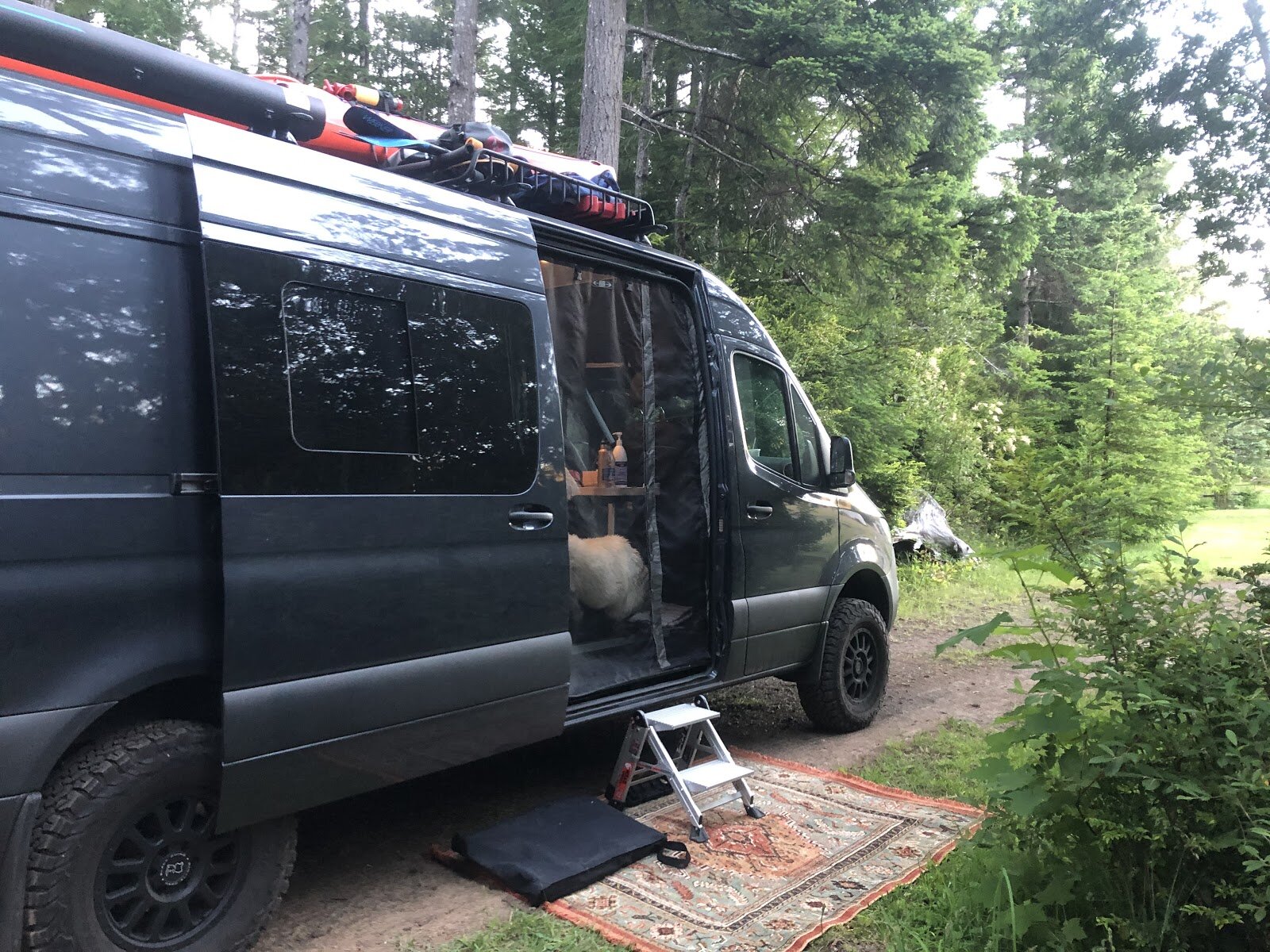
VIDEO: Hey, Noah! How Do You Sleep a Family of Five In One Of Your Vans?
As part of our ongoing “Hey, Noah!” video series, today we answer one of the most commonly asked questions: how do you sleep a family of five in one of your vans? Most people assume that #vanlife is only possible without kids or friends along for the ride, but we beg to differ! You will be pleasantly surprised to find out that there are three different bed options in our vans; more than enough room to sleep a family of five!
For more information on Luno mattresses: https://lunolife.com/collections/shop-air-mattresses
VIDEO: Hey, Noah! How Do You Stay Warm In The Van In The Winter?
As part of our ongoing “Hey, Noah!” series, today we discuss one of the most commonly asked questions: how do you stay warm in the van in the winter? It’s an important question that we don’t take lightly! You’ll be pleasantly surprised to hear about the lengths we go to ensure you stay cozy all winter long in your home on wheels.
Make sure to checkout our “Hey, Noah!” video with Andrew Legge, the founder of Havelock Wool to learn more about why they are our insulation of choice: https://www.youtube.com/watch?v=aixJ2nm9MXQ
And don’t forget to check out the other videos in the “Hey, Noah! | Your Van Conversion Questions Answered” series to learn more about our sustainable, luxury Sprinter van builds.
VIDEO: Hey, Noah! What Kind of Mileage do Sprinter Vans Get?
One question we get asked a lot is what kind of gas mileage our Sprinter vans get. As part of a growing series called “Hey, Noah! | Your Van Conversion Questions Answered”, we answer that question for you. Make sure to check out the other videos in the series to learn more about our luxury Sprinter van builds!
VIDEO: Hey, Noah! What’s the Deal With Van Insulation?
We are proud to say that we use the highest quality and most sustainable building materials in our vans that we possibly can, and our choice of insulation is no different. So when it came time to choose what brand insulation to use in our vans, Havelock Wool proved to be the perfect fit.
In today’s video, Andrew Legge, the founder of Havelock Wool joins Noah at the van shop to discuss the features that make their product our insulation of choice.
Make sure to check out the other videos in the “Hey, Noah! | Your Van Conversion Questions Answered” series to learn more about the sustainable, luxury Sprinter van builds at Muse & Co. Outdoors.
